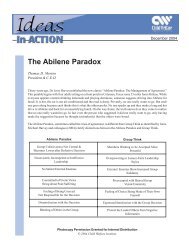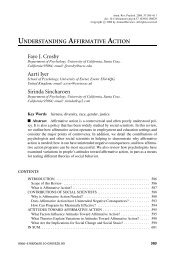Do Nice Guysâand GalsâReally Finish Last - Southeastern ...
Do Nice Guysâand GalsâReally Finish Last - Southeastern ...
Do Nice Guysâand GalsâReally Finish Last - Southeastern ...
You also want an ePaper? Increase the reach of your titles
YUMPU automatically turns print PDFs into web optimized ePapers that Google loves.
16 JUDGE, LIVINGSTON, AND HURST<br />
behavior has little effect on women’s income. In general, whether<br />
agreeable or not, men still earn more than women. These tendencies<br />
hold across cohorts and across occupations. Given the positive<br />
contributions made by agreeable people, demonstrated in prior<br />
research, it seems that the income penalty for agreeableness is out<br />
of proportion with its performance effects. Rather, for men and for<br />
women, the effects may be due more to expectations for behavior<br />
appropriate to one’s gender. This research raises important questions<br />
about the standards according to which people are evaluated<br />
and sheds further light on the issue of wage inequalities. In<br />
particular, it serves as a caveat to popular sources of career advice<br />
that either exhort people to be nice—or not. Closing the gender<br />
gap seems to hinge less on changing women’s behavior than it<br />
does on changing the minds of decision makers.<br />
References<br />
Abele, A. E., Cuddy, A. J. C., Judd, C. M., & Yzerbyt, V. Y. (2008).<br />
Fundamental dimensions of social judgment: A view from different<br />
perspectives. European Journal of Social Psychology, 38, 1063–1065.<br />
Abele, A. E., Uchronski, M., Suitner, C., & Wojciszke, B. (2008). Towards<br />
and operationalization of fundamental dimensions of agency and communion:<br />
Trait content ratings in five countries considering valence and<br />
frequency of word occurrence. European Journal of Social Psychology,<br />
38, 1202–1217. doi:10.1002/ejsp.575<br />
Amabile, T. M., & Glazebrook, A. H. (1982). A negativity bias in interpersonal<br />
evaluation. Journal of Experimental Social Psychology, 18,<br />
1–22. doi:10.1016/0022-1031(82)90078-6<br />
Ames, D. R., & Flynn, F. J. (2007). What breaks a leader: The curvilinear<br />
relation between assertiveness and leadership. Journal of Personality<br />
and Social Psychology, 92, 307–324. doi:10.1037/0022-3514.92.2.307<br />
Auster, E. R. (1989). Task characteristics as a bridge between macro and<br />
micro level research on salary inequality between men and women.<br />
Academy of Management Review, 14, 173–193.<br />
Azen, R., & Budescu, D. V. (2003). The dominance analysis approach for<br />
comparing predictors in multiple regression. Psychological Methods, 8,<br />
129–148. doi:10.1037/1082-989X.8.2.129<br />
Bakan, D. (1966). The duality of human existence. Chicago, IL: Rand<br />
McNally.<br />
Balch, D. R., & Armstrong, R. W. (2010). Ethical marginality: The Icarus<br />
syndrome and banality of wrongdoing. Journal of Business Ethics, 92,<br />
291–303. doi:10.1007/s10551-009-0155-4<br />
Baldridge, D. C., Eddleston, K. A., & Veiga, J. F. (2006). Saying no to<br />
being uprooted: The impact of family and gender on willingness to<br />
relocate. Journal of Occupational and Organizational Psychology, 79,<br />
131–149. doi:10.1348/096317905X53174<br />
Barrick, M. R., Stewart, G. L., & Piotrowski, M. (2002). Personality and<br />
job performance: Test of the mediating effects of motivation among<br />
sales representatives. Journal of Applied Psychology, 87, 43–51. doi:<br />
10.1037/0021-9010.87.1.43<br />
Barry, B., & Friedman, R. (1998). Bargainer characteristics in distributive<br />
and integrative negotiation. Journal of Personality and Social Psychology,<br />
74, 345–359. doi:10.1037/0022-3514.74.2.345<br />
Benyus, J. M., Bremmer, I., Pujadas, J., Christakis, N. A., Collier, P.,<br />
Warnholz, J., ...Sviokla, J. (2009). Breakthrough ideas for 2009.<br />
Harvard Business Review, 87, 19–40. Retrieved from http://<br />
search.ebscohost.com/login.aspx?directtrue&dbbth&AN<br />
36193663&siteehost-live<br />
Biddle, B. J. (1979). Role theory: Expectations, identities, and behaviors.<br />
New York, NY: Academic Press.<br />
Blau, F. D., & Ferber, M. A. (1992). The economics of women, men, and<br />
work (2nd ed.). Englewood Cliffs, NJ: Prentice-Hall.<br />
Blau, F. D., & Kahn, L. M. (1994). Rising wage inequality and the U.S.<br />
gender gap. American Economic Review, 84, 23.<br />
Blau, F. D., & Kahn, L. M. (2006). The U.S. gender pay gap in the 1990s:<br />
Slowing convergence. Industrial and Labor Relations Review, 60, 45–<br />
66.<br />
Bouchard, T. J., & Loehlin, J. C. (2001). Genes, evolution, and personality.<br />
Behavior Genetics, 31, 243–273. doi:10.1023/A:1012294324713<br />
Bozionelos, N. (2004). The relationship between disposition and career<br />
success: A British study. Journal of Occupational and Organizational<br />
Psychology, 77, 403–420. doi:10.1348/0963179041752682<br />
Brescoll, V. L., & Uhlmann, E. L. (2005). Attitudes toward traditional and<br />
nontraditional parents. Psychology of Women Quarterly, 29, 436–445.<br />
doi:10.1111/j.1471-6402.2005.00244.x<br />
Brescoll, V. L., & Uhlmann, E. L. (2008). Can an angry woman get ahead?<br />
Status conferral, gender, and expression of emotion in the workplace.<br />
Psychological Science, 19, 268–275. doi:10.1111/j.1467-9280<br />
.2008.02079.x<br />
Bureau of Labor Statistics. (2006, January). Employment & earnings.<br />
Washington, DC: U.S. Census Bureau.<br />
Campbell, W. K., Bonacci, A. M., Shelton, J., Exline, J. J., & Bushman,<br />
B. J. (2004). Psychological entitlement: Interpersonal consequences and<br />
validation of a self-report measure. Journal of Personality Assessment,<br />
83, 29–45. doi:10.1207/s15327752jpa8301_04<br />
Caspi, A., Roberts, B. W., & Shiner, R. L. (2005). Personality development:<br />
Stability and change. Annual Review of Psychology, 56, 453–484.<br />
doi:10.1146/annurev.psych.55.090902.141913<br />
Chow, G. C. (1960). Tests of equality between sets of coefficients in two<br />
linear regressions. Econometrica, 28, 591–605. doi:10.2307/1910133<br />
Clogg, C. C., Petkova, E., & Haritou, A. (1995). Statistical methods for<br />
comparing regression coefficients between models. American Journal of<br />
Sociology, 100, 1261–1293. doi:10.1086/230638<br />
Coltrane, S. (1989). Household labor and the routine production of gender.<br />
Social Problems, 36, 473–490. doi:10.1525/sp.1989.36.5.03x0006f<br />
Costa, P. T., Jr., Terracciano, A., & McCrae, R. R. (2001). Gender<br />
differences in personality traits across cultures: Robust and surprising<br />
findings. Journal of Personality and Social Psychology, 81, 322–331.<br />
doi:10.1037/0022-3514.81.2.322<br />
Costa, P. T., Jr., & McCrae, R. R. (1992). The NEO PI-R professional<br />
manual. Odessa, FL: Psychological Assessment Resources.<br />
Crocker, J., & Canevello, A. (2008). Creating and undermining social<br />
support in communal relationships: The role of compassionate and<br />
self-image goals. Journal of Personality and Social Psychology, 95,<br />
555–575. doi:10.1037/0022-3514.95.3.555<br />
Cuperman, R., & Ickes, W. (2009). Big Five predictors of behavior and<br />
perceptions in initial dyadic interactions: Personality similarity helps<br />
extraverts and introverts, but hurts “disagreeables.” Journal of Personality<br />
and Social Psychology, 97, 667–684. doi:10.1037/a0015741<br />
Decuyper, M., De Pauw, S., De Fruyt, F., De Bolle, M., & De Clercq, B. J.<br />
(2009). A meta-analysis of psychopathy-, antisocial PD- and FFM<br />
associations. European Journal of Personality, 23, 531–565. doi:10<br />
.1002/per.729<br />
Derefinko, K. J., & Lynam, D. R. (2006). Convergence and divergence<br />
among self-report psychopathy measures: A personality-based approach.<br />
Journal of Personality Disorders, 20, 261–280. doi:10.1521/pedi<br />
.2006.20.3.261<br />
DeYoung, C. G., Quilty, L. C., & Peterson, J. B. (2007). Between facets<br />
and domains: 10 aspects of the Big Five. Journal of Personality and<br />
Social Psychology, 93, 880–896. doi:10.1037/0022-3514.93.5.880<br />
Deutsch, F. M., & Saxon, S. E. (1998). Traditional ideologies, nontraditional<br />
lives. Sex Roles: A Journal of Research, 38, 331–362.<br />
Digman, J. M. (1997). Higher-order factors of the Big Five. Journal of<br />
Personality and Social Psychology, 73, 1246–1256. doi:10.1037/0022-<br />
3514.73.6.1246<br />
Duncan, K. C., & Prus, M. J. (1992). Atrophy rates for intermittent<br />
employment for married and never-married women: A test of human














